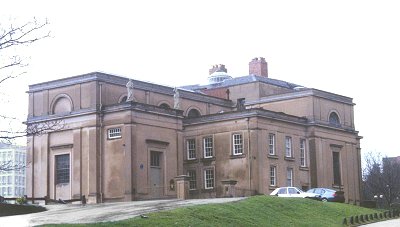Anti-Catholic agitation in
Wolverhampton (part 2)
1829-54: the removal of
disabilities and the fortress chapel
Within less than a year of the new chapel of SS Peter & Paul being
opened for worship, the Wolverhampton Chronicle published one of its
very rare Saturday supplements because of "the great anxiety manifested
by the public to be acquainted with the measures intended to be
introduced for the removal of Roman Catholic Disabilities". [WC
[supplement] 7th
Mar 1829].
There were a number of letters in the correspondence columns throughout
February and March 1829 from local Protestants who feared the increase
in Catholic influence that would be a consequence of Emancipation. These
fears and the reassurances from Bishop Walsh were remarkably similar to
those that were heard twenty-one years later, after the Restoration of
the Catholic hierarchy in England and Wales. Walsh explained that Roman
Catholics owed spiritual obedience only to Pope Pius VIII, while "full
and undivided allegiance in all civil and temporal matters is due ....
to our beloved sovereign King George IV". [WC 29th
April 1829].
During the following year, correspondence and reports of lectures
concerning the alleged place of image-worship in the Church of Rome
prompted the Revs P. O'Sullivan and F. Mostyn to complain that the
Chronicle had broken its previous promise to cease printing details of
the controversy surrounding this matter. They explained that images were
used simply to help "recall our wandering thoughts and to enliven our
memories towards heavenly things". [WC 5th Jan 1831].
 |
The Church of Ss Peter and
Paul with "many of the qualities of a fortress". The
windowed block is a later addition. |
The design and construction of SS Peter & Paul's chapel shows just how
important contemporary Catholics felt security to be in Wolverhampton at
that time. A London court case on Boxing Day 1831 brought to light some
interesting details. Part of the evidence against Ann Williams, who
faced several charges of robbery, was a letter from James Peck, a noted
thief. Mrs Williams asked him to appraise the possibility of executing a
successful burglary at the chapel, but his reply had offered no
encouragement.
"As for Enny body thinking to crack into that place, the [sic]
might as well think of cracking into Newgate as there is no windows
hall round this chapel. It consists of scuy lites [sky lights], and
there is but one door, an wen enny body goes through that door, the
have got to pass through two more doors which is very strong bard on
the inside .... It is a thing impossable to think about getting into
that place without being found out…." [WC 28th Dec 1831].
It is most likely that in building a chapel with many of the qualities
of a fortress, the Catholics were more concerned about the actions of
their more violent religious opponents than the criminal deeds of petty
thieves.
There appears to have been no further outbreaks of anti-Catholic
feeling in Wolverhampton until the spring of 1845, when the controversy
broke out over the Parliamentary Bill to give an additional and
permanent grant to the Roman Catholic College of Maynooth. Although a
number of letters from angry Protestants appeared in the local Press,
there does not seem to have been a great deal of support for the
suggestion contained in one such item of correspondence: "I do trust
that some influential townsmen will take the necessary steps to convene
a meeting; and I doubt not that a powerful response will be found in the
hearts of a majority of our fellow townsmen". [WC 14th May
1845 "Letter from a Protestant"] The Chronicle, however, realized that
little could be done to alter the course of events, no matter how
desirable. "We see no probable plan by which the strongly, and we may
say, nationally disapproved measure is likely to be set aside ....
Failures in high quarters, we might add, deceptions - have almost
removed all hope ...." [WC 23rd April 1845].
The Maynooth debate passed off quietly in Wolverhampton, probably
because at that time its Catholic community was still relatively small,
"respectable", and predominantly English. This state of affairs changed
dramatically during the following five years as thousands of Irish
invaded the town in search of employment and accommodation. The ghetto
area of Caribee Island was flooded by the huge famine influx of
impoverished and disease-ridden Irish, "and the social misery which was
a by-product of such a brutalizing environment, together with a ready
acceptance of the notion that Irish peasant society was inherently
violent" [O’Tuaghaig op cit p.162] formed for many of the less
sympathetic townsmen an explanation for all Irish troubles and
misfortunes.
|

